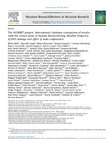The hCOMET Project: International Database Comparison of Results with the Comet Assay in Human Biomonitoring. Baseline Frequency of DNA Damage and Effect of Main Confounders

Ver/Abrir
Use este enlace para citar
http://hdl.handle.net/2183/29582
Excepto si se señala otra cosa, la licencia del ítem se describe como Atribución-NoComercial-SinDerivadas 4.0 Internacional
Colecciones
- Investigación (FEDU) [938]
Metadatos
Mostrar el registro completo del ítemTítulo
The hCOMET Project: International Database Comparison of Results with the Comet Assay in Human Biomonitoring. Baseline Frequency of DNA Damage and Effect of Main ConfoundersAutor(es)
Fecha
2021Cita bibliográfica
Milić M, Ceppi M, Bruzzone M, Azqueta A, Brunborg G, Ladeira C, et al. The hCOMET project: international database comparison of results with the comet assay in human biomonitoring (baseline frequency of DNA damage and effect of main confounders). Mutat Res Rev Mutat Res. 2021;787:108371.
Resumen
[Abstract] The alkaline comet assay, or single cell gel electrophoresis, is one of the most popular methods for assessing DNA damage in human population. One of the open issues concerning this assay is the identification of those factors that can explain the large inter-individual and inter-laboratory variation. International collaborative initiatives such as the hCOMET project - a COST Action launched in 2016 - represent a valuable tool to meet this challenge. The aims of hCOMET were to establish reference values for the level of DNA damage in humans, to investigate the effect of host factors, lifestyle and exposure to genotoxic agents, and to compare different sources of assay variability. A database of 19,320 subjects was generated, pooling data from 105 studies run by 44 laboratories in 26 countries between 1999 and 2019. A mixed random effect log-linear model, in parallel with a classic meta-analysis, was applied to take into account the extensive heterogeneity of data, due to descriptor, specimen and protocol variability. As a result of this analysis interquartile intervals of DNA strand breaks (which includes alkali-labile sites) were reported for tail intensity, tail length, and tail moment (comet assay descriptors). A small variation by age was reported in some datasets, suggesting higher DNA damage in oldest age-classes, while no effect could be shown for sex or smoking habit, although the lack of data on heavy smokers has still to be considered. Finally, highly significant differences in DNA damage were found for most exposures investigated in specific studies. In conclusion, these data, which confirm that DNA damage measured by the comet assay is an excellent biomarker of exposure in several conditions, may contribute to improving the quality of study design and to the standardization of results of the comet assay in human populations.
Palabras clave
Comet assay
DNA damage
Pooled analysis
Human biomonitoring
Biomarkers
DNA damage
Pooled analysis
Human biomonitoring
Biomarkers
Versión del editor
Derechos
Atribución-NoComercial-SinDerivadas 4.0 Internacional






